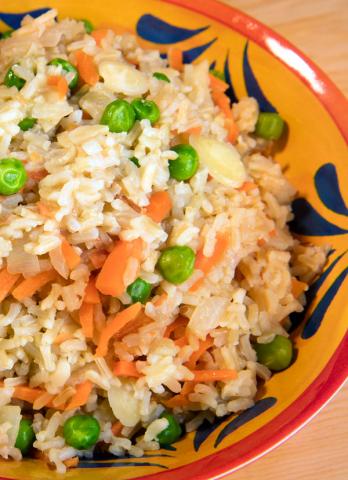
Here are a few budget friendly tips to help save money on holiday meals.
- Plan your menu carefully. Check what food and ingredients you already have and then make your shopping list. Look at online and print grocery store ads. Using MyPlate as a guide to plan your holiday meals can be helpful.
- Prepare less. Think about having less food. This could include less of the expensive items and a smaller number of dishes served. However, consider keeping the holiday foods important to your family traditions on the menu.
- Trim protein costs. A whole turkey is less expensive per serving than a turkey breast. Lean roast beef, pork loin and some types of fish, such as cod or flounder are lower cost options. Consider serving soup or a casserole that can extend your protein dollar.
- Serve it simple. Sometimes serving dishes with less ingredients can be healthier as well as save time and money. For example, this recipe for Lemony Green Beans might be a tasty alternative for a green bean casserole.
- Shop smart. Beware of store displays that are designed to tempt you to buy things you didn't plan on purchasing. Using unit pricing to help compare different brands and different sizes of products can help you save money. Prefer to do your grocery shopping online? We've got some great tips for saving money online.
- Cook ahead. Instead of purchasing some of the more expensive convenience items, many of your dishes can be prepared or partially prepared a day or two in advance: roasting a turkey, cranberry relish, cube and dry bread for stuffing, and pre-prep vegetables for salads and casseroles.
- Make smart beverage choices. Water is easy on the wallet and people typically will drink less of the other beverages if they can use water to quench their thirst. Regular soda, energy or sports drinks, and other sweet drinks can be expensive and usually contain a lot of added sugar.
- Get your money's worth of leftovers. Handle leftovers safely so that they can be used for meals in the days ahead. Always wash hands with soap and water before handling food. Leftovers should be stored within two hours of cooking. Divide leftovers into smaller portions and refrigerate in covered shallow containers so they cool quickly. Use refrigerated leftovers within 3 to 4 days or freeze for longer storage.
Low-cost Holiday Recipes
Here are a few quick and easy recipes for your next holiday meal:
Sources:
Holiday Leftovers? We've Got You Covered, United States Department of Agriculture
Plan Your Weekly Meals, MyPlate, United States Department of Agriculture
This article has been peer-reviewed.
Tags:
Feedback Form
Feedback Form
If you do not see the article, please scroll up the page.
The Nutrition Education Program (NEP) delivers evidence-based nutrition education and obesity prevention interventions through a combination of education strategies coupled with multi-level community changes that occur within the environment to promote healthy eating and active lifestyles.
This material was funded by USDA's Supplemental Nutrition Assistance Program – SNAP and Expanded Food & Nutrition Education Program (EFNEP).











